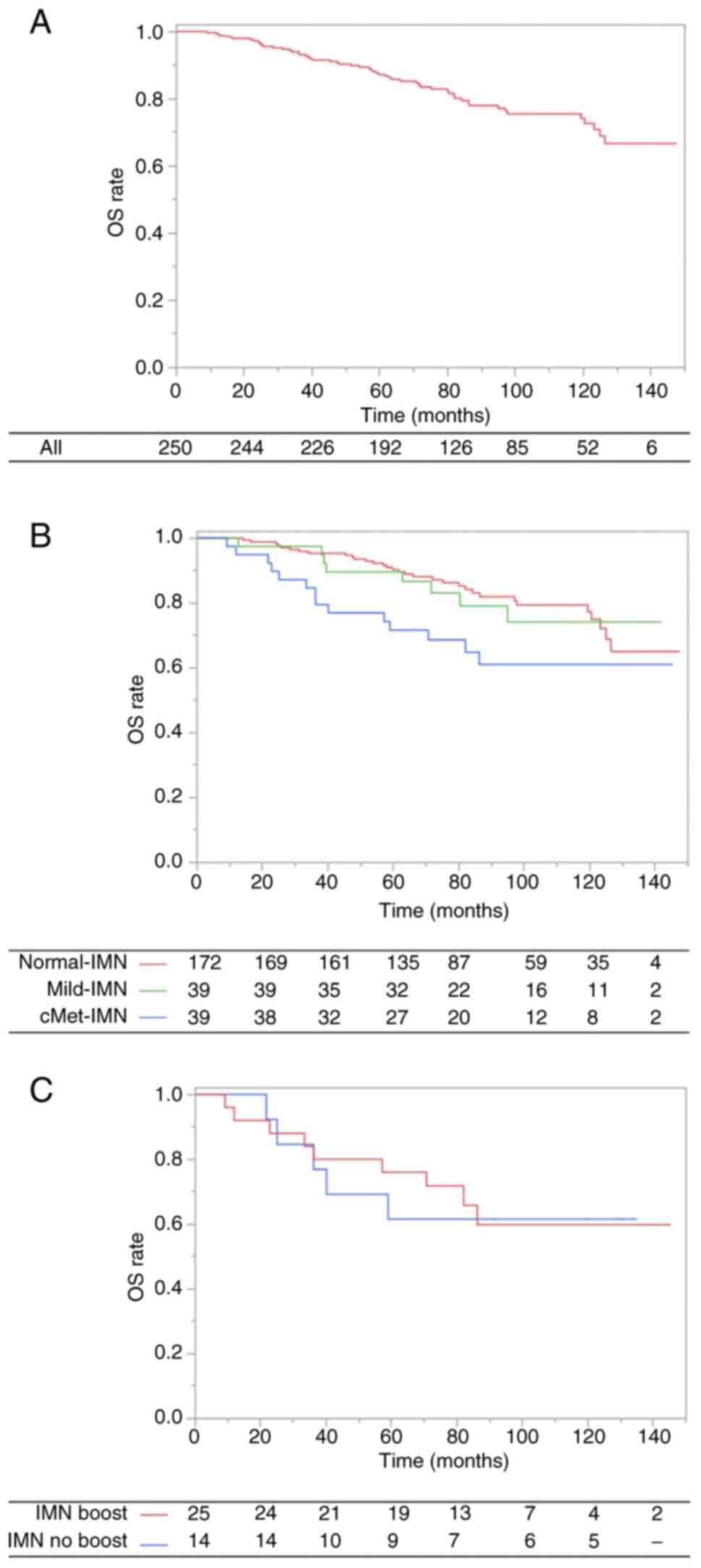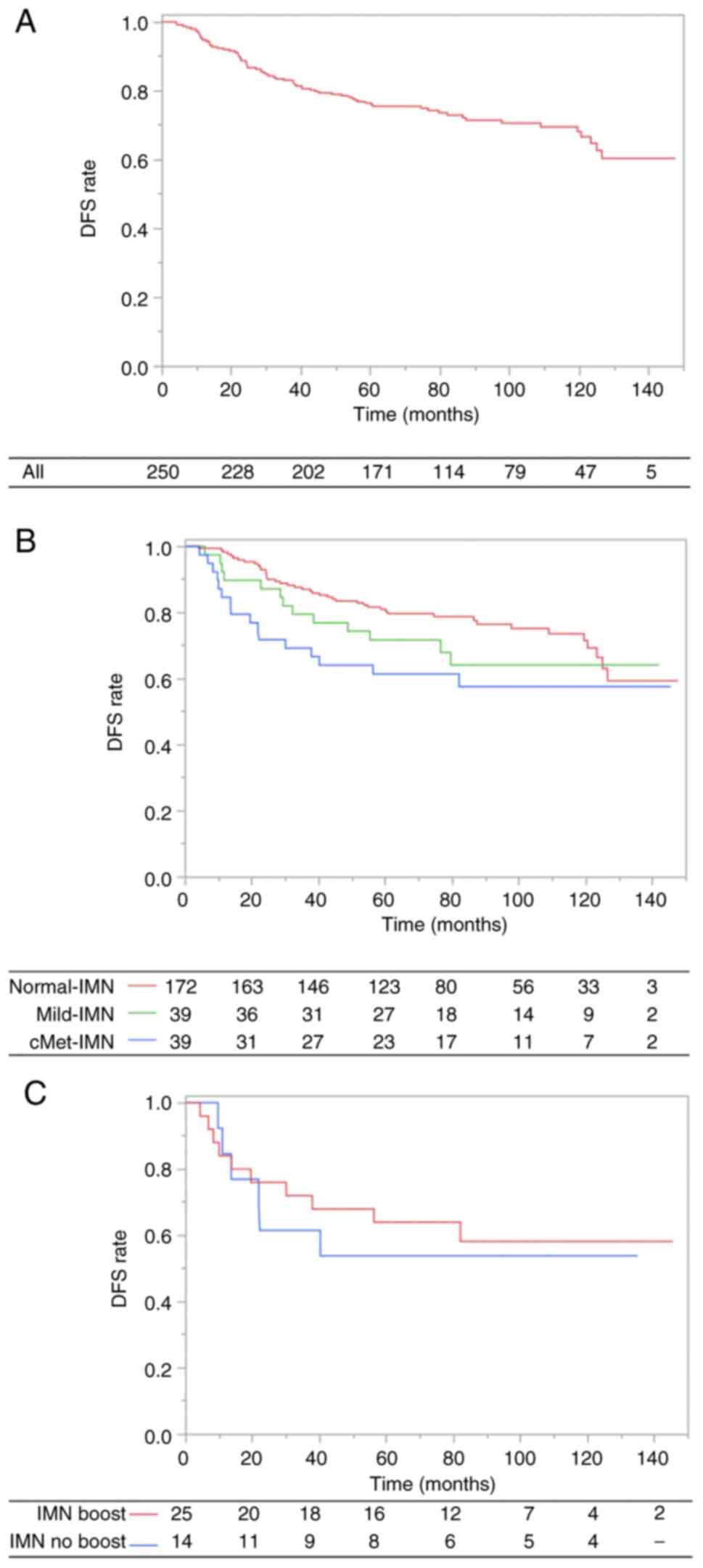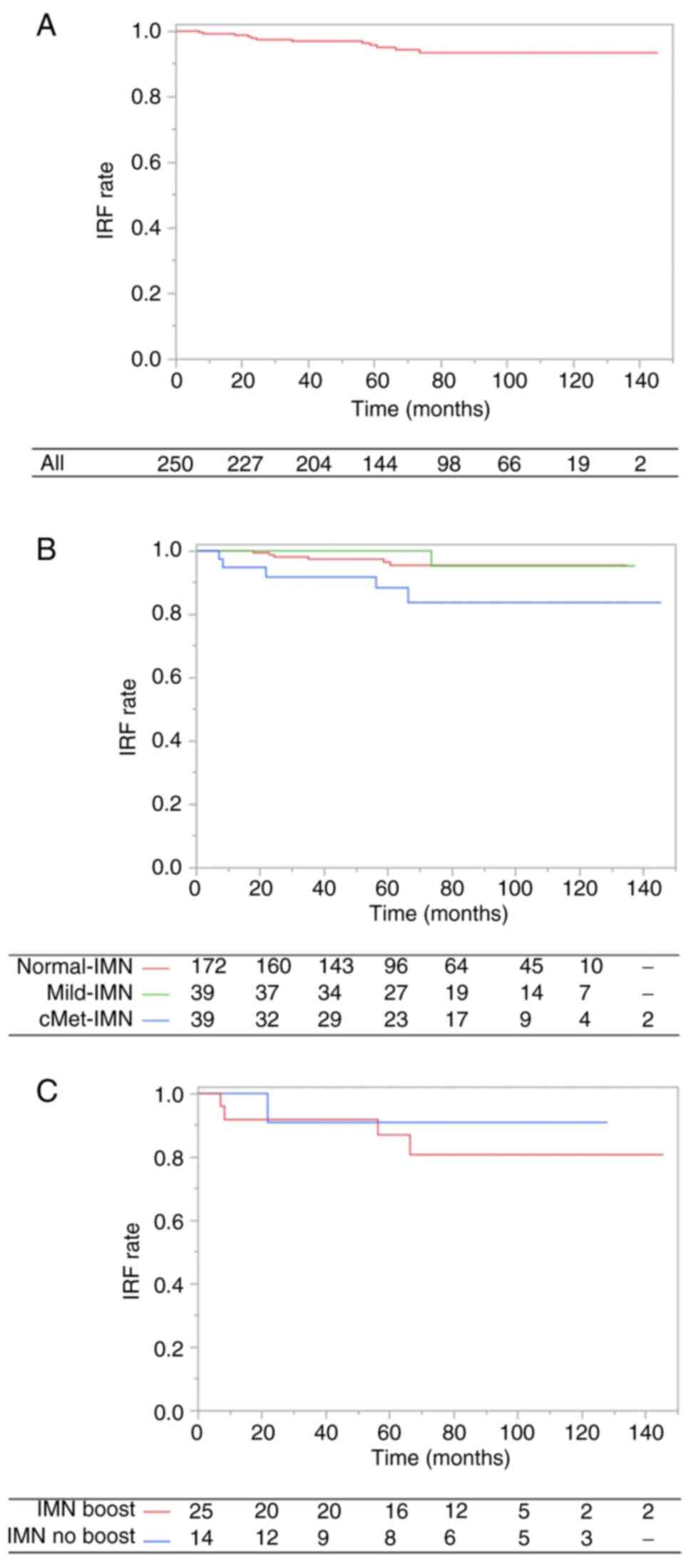|
1
|
Sung H, Ferlay J, Siegel RL, Laversanne M,
Soerjomataram I, Jemal A and Bray F: Global cancer statistics 2020:
GLOBOCAN estimates of incidence and mortality worldwide for 36
cancers in 185 countries. CA Cancer J Clin. 71:209–249. 2021.
View Article : Google Scholar : PubMed/NCBI
|
|
2
|
Iwamoto T, Kumamaru H, Niikura N, Sagara
Y, Miyashita M, Konishi T, Sanuki N, Tanakura K, Nagahashi M,
Hayashi N, et al: Survival trends and patient characteristics
between 2004 and 2016 for breast cancer in Japan based on the
national clinical database-breast cancer registry. Breast Cancer.
31:185–194. 2024. View Article : Google Scholar : PubMed/NCBI
|
|
3
|
Chen RC, Lin NU, Golshan M, Harris JR and
Bellon JR: Internal mammary nodes in breast cancer: Diagnosis and
implications for patient management-a systematic review. J Clin
Oncol. 26:4981–4989. 2008. View Article : Google Scholar : PubMed/NCBI
|
|
4
|
Hassiotou F and Geddes D: Anatomy of the
human mammary gland: Current status of knowledge. Clin Anat.
26:29–48. 2013. View
Article : Google Scholar : PubMed/NCBI
|
|
5
|
Huang O, Wang L, Shen K, Lin H, Hu Z, Liu
G, Wu J, Lu J, Shao Z, Han Q and Shen Z: Breast cancer
subpopulation with high risk of internal mammary lymph nodes
metastasis: Analysis of 2,269 Chinese breast cancer patients
treated with extended radical mastectomy. Breast Cancer Res Treat.
107:379–387. 2008. View Article : Google Scholar : PubMed/NCBI
|
|
6
|
Katz A, Strom EA, Buchholz TA, Thames HD,
Smith CD, Jhingran A, Hortobagyi G, Buzdar AU, Theriault R,
Singletary SE and McNeese MD: Locoregional recurrence patterns
after mastectomy and doxorubicin-based chemotherapy: Implications
for postoperative irradiation. J Clin Oncol. 18:2817–2827. 2000.
View Article : Google Scholar : PubMed/NCBI
|
|
7
|
Gradishar WJ, Moran MS, Abraham J, Aft R,
Agnese D, Allison KH, Anderson B, Burstein HJ, Chew H, Dang C, et
al: Breast cancer, version 3.2022, NCCN clinical practice
guidelines in oncology. J Natl Compr Canc Netw. 20:691–722. 2022.
View Article : Google Scholar : PubMed/NCBI
|
|
8
|
Yamauchi C, Yoshimura M, Sekiguchi K,
Hamamoto Y, Nakajima N, Sanuki N, Ogo E, Oguchi M, Saji S and Iwata
H: The Japanese breast cancer society clinical practice guideline
for radiation treatment of breast cancer, 2018 edition. Breast
Cancer. 27:9–16. 2020. View Article : Google Scholar : PubMed/NCBI
|
|
9
|
Aleknavičius E, Atkočius V, Kuzmickienė I
and Steponavičienė R: Postmastectomy internal mammary nodal
irradiation: A long-term outcome. Medicina (Kaunas). 50:230–236.
2014. View Article : Google Scholar : PubMed/NCBI
|
|
10
|
Thorsen LB, Offersen BV, Danø H, Berg M,
Jensen I, Pedersen AN, Zimmermann SJ, Brodersen HJ, Overgaard M and
Overgaard J: DBCG-IMN: A population-based cohort study on the
effect of internal mammary node irradiation in early node-positive
breast cancer. J Clin Oncol. 34:314–320. 2016. View Article : Google Scholar : PubMed/NCBI
|
|
11
|
Kim YB, Byun HK, Kim DY, Ahn SJ, Lee HS,
Park W, Kim SS, Kim JH, Lee KC, Lee IJ, et al: Effect of elective
internal mammary node irradiation on disease-free survival in women
with node-positive breast cancer: A randomized phase 3 clinical
trial. JAMA Oncol. 8:96–105. 2022. View Article : Google Scholar : PubMed/NCBI
|
|
12
|
Zhang X, Liu Y, Luo H and Zhang J: PET/CT
and MRI for identifying axillary lymph node metastases in breast
cancer patients: Systematic review and meta-analysis. J Magn Reson
Imaging. 52:1840–1851. 2020. View Article : Google Scholar : PubMed/NCBI
|
|
13
|
Riegger C, Herrmann J, Nagarajah J,
Hecktor J, Kuemmel S, Otterbach F, Hahn S, Bockisch A, Lauenstein
T, Antoch G and Heusner TA: Whole-body FDG PET/CT is more accurate
than conventional imaging for staging primary breast cancer
patients. Eur J Nucl Med Mol Imaging. 39:852–863. 2012. View Article : Google Scholar : PubMed/NCBI
|
|
14
|
Jochelson MS, Lebron L, Jacobs SS, Zheng
J, Moskowitz CS, Powell SN, Sacchini V, Ulaner GA, Morris EA and
Dershaw DD: Detection of internal mammary adenopathy in patients
with breast cancer by PET/CT and MRI. AJR Am J Roentgenol.
205:899–904. 2015. View Article : Google Scholar : PubMed/NCBI
|
|
15
|
Kalli S, Semine A, Cohen S, Naber SP,
Makim SS and Bahl M: American joint committee on cancer's staging
system for breast cancer, eighth edition: What the radiologist
needs to know. Radiographics. 38:1921–1933. 2018. View Article : Google Scholar : PubMed/NCBI
|
|
16
|
Zhang YJ, Oh JL, Whitman GJ, Iyengar P, Yu
TK, Tereffe W, Woodward WA, Perkins G, Buchholz TA and Strom EA:
Clinically apparent internal mammary nodal metastasis in patients
with advanced breast cancer: Incidence and local control. Int J
Radiat Oncol Biol Phys. 77:1113–1119. 2010. View Article : Google Scholar : PubMed/NCBI
|
|
17
|
Lee HW and Kim SH: Breast magnetic
resonance imaging for assessment of internal mammary lymph node
status in breast cancer. J Breast Cancer. 19:191–198. 2016.
View Article : Google Scholar : PubMed/NCBI
|
|
18
|
Kinoshita T, Odagiri K, Andoh K, Doiuchi
T, Sugimura K, Shiotani S and Asaga T: Evaluation of small internal
mammary lymph node metastases in breast cancer by MRI. Radiat Med.
17:189–193. 1999.PubMed/NCBI
|
|
19
|
Tsuda H, Akiyama F, Kurosumi M, Sakamoto G
and Watanabe T: Establishment of histological criteria for
high-risk node-negative breast carcinoma for a multi-institutional
randomized clinical trial of adjuvant therapy. Japan national
surgical adjuvant study of breast cancer (NSAS-BC) pathology
section. Jpn J Clin Oncol. 28:486–491. 1998. View Article : Google Scholar : PubMed/NCBI
|
|
20
|
Oken MM, Creech RH, Tormey DC, Horton J,
Davis TE, McFadden ET and Carbone PP: Toxicity and response
criteria of the eastern cooperative oncology group. Am J Clin
Oncol. 5:649–655. 1982. View Article : Google Scholar : PubMed/NCBI
|
|
21
|
Liang X, Yu J, Wen B, Xie J, Cai Q and
Yang Q: MRI and FDG-PET/CT based assessment of axillary lymph node
metastasis in early breast cancer: A meta-analysis. Clin Radiol.
72:295–301. 2017. View Article : Google Scholar : PubMed/NCBI
|
|
22
|
Sachdev S, Goodman CR, Neuschler E,
Kalakota K, Cutright D, Donnelly ED, Hayes JP, Prescott AE,
Mirabelli G and Strauss JB: Radiotherapy of MRI-detected involved
internal mammary lymph nodes in breast cancer. Radiat Oncol.
12:1992017. View Article : Google Scholar : PubMed/NCBI
|
|
23
|
Kim J, Chang JS, Choi SH, Kim YB, Keum KC,
Suh CO, Yang G, Cho Y, Kim JW and Lee IJ: Radiotherapy for initial
clinically positive internal mammary nodes in breast cancer. Radiat
Oncol. 37:91–100. 2019. View Article : Google Scholar : PubMed/NCBI
|
|
24
|
Yang K, Kim H, Choi DH, Park W, Noh JM and
Cho WK: Optimal radiotherapy for patients with internal mammary
lymph node metastasis from breast cancer. Radiat Oncol. 15:162020.
View Article : Google Scholar : PubMed/NCBI
|












